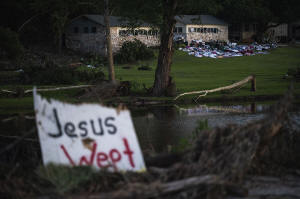FEMA removed dozens of Camp Mystic buildings from 100-year flood map
before expansion, records show
[July 12, 2025]
By RYAN J. FOLEY, CHRISTOPHER L. KELLER, and JIM MUSTIAN
Federal regulators repeatedly granted appeals to remove Camp Mystic's
buildings from their 100-year flood map, loosening oversight as the camp
operated and expanded in a dangerous flood plain in the years before
rushing waters swept away children and counselors, a review by The
Associated Press found.
The Federal Emergency Management Agency included the prestigious girls'
summer camp in a “Special Flood Hazard Area” in its National Flood
Insurance map for Kerr County in 2011, which means it was required to
have flood insurance and faced tighter regulation on any future
construction projects.
That designation means an area is likely to be inundated during a
100-year flood — one severe enough that it only has a 1% chance of
happening in any given year.
Located in a low-lying area along the Guadalupe River in a region known
as flash flood alley, Camp Mystic lost at least 27 campers and
counselors and longtime owner Dick Eastland when historic floodwaters
tore through its property before dawn on July 4.
The flood was far more severe than the 100-year event envisioned by
FEMA, experts said, and moved so quickly in the middle of the night that
it caught many off guard in a county that lacked a warning system.

But Syracuse University associate professor Sarah Pralle, who has
extensively studied FEMA’s flood map determinations, said it was
“particularly disturbing” that a camp in charge of the safety of so many
young people would receive exemptions from basic flood regulation.
“It’s a mystery to me why they weren’t taking proactive steps to move
structures away from the risk, let alone challenging what seems like a
very reasonable map that shows these structures were in the 100-year
flood zone,” she said.
Camp Mystic didn’t respond to emails seeking comment and calls to it
rang unanswered. The camp has called the flood an “unimaginable tragedy”
and added in a statement Thursday that it had restored power for the
purpose of communicating with its supporters.
FEMA exempted buildings at old and new sites
In response to an appeal, FEMA in 2013 amended the county's flood map to
remove 15 of the camp’s buildings from the hazard area. Records show
that those buildings were part of the 99-year-old Camp Mystic Guadalupe,
which was devastated by last week’s flood.
After further appeals, FEMA removed 15 more Camp Mystic structures in
2019 and 2020 from the designation. Those buildings were located on
nearby Camp Mystic Cypress Lake, a sister site that opened to campers in
2020 as part of a major expansion and suffered less damage in the flood.
Campers have said the cabins at Cypress Lake withstood significant
damage, but those nicknamed "the flats” at the Guadalupe River camp were
inundated.
Experts say Camp Mystic's requests to amend the FEMA map could have been
an attempt to avoid the requirement to carry flood insurance, to lower
the camp’s insurance premiums or to pave the way for renovating or
adding new structures under less costly regulations.
Pralle said the appeals were not surprising because communities and
property owners have used them successfully to shield specific
properties from regulation.
Analysis shows flood risks at both camp sites
Regardless of FEMA's determinations, the risk was obvious.
At least 12 structures at Camp Mystic Guadalupe were fully within FEMA's
100-year flood plain, and a few more were partially in that zone,
according to an AP analysis of data provided by First Street, a data
science company that specializes in modeling climate risk.
Jeremy Porter, the head of climate implications at First Street, said
FEMA's flood insurance map underestimates flood risks. That's because it
fails to take into account the effects of heavy precipitation on smaller
waterways such as streams and creeks. First Street's model puts nearly
all of Camp Mystic Guadalupe at risk during a 100-year flood.

[to top of second column]
|

Camper's belongings sit outside one of Camp Mystic's cabins near the
Guadalupe River after a flash flood swept through the area Monday,
July 7, 2025, in Hunt, Texas. (AP Photo/Eli Hartman, File)

The buildings at the newer Cypress Lake site are farther from the
south fork of the flood-prone river but adjacent to Cypress Creek.
FEMA's flood plain doesn't consider the small waterway a risk.
However, First Street’s model, which takes into account heavy rain
and runoff reaching the creek, shows that the majority of the
Cypress Lake site lies within an area that has a 1% chance of
flooding in any given year.
In a statement, FEMA downplayed the significance of the flood map
amendments.
“Flood maps are snapshots in time designed to show minimum standards
for floodplain management and the highest risk areas for flood
insurance,” the agency wrote. “They are not predictions of where it
will flood, and they don’t show where it has flooded before.”
An ‘arduous' appeal process can help property owners
Property owners challenging FEMA's map designations hire engineers
to conduct detailed studies to show where they believe the 100-year
flood plain should actually be drawn. That is a “pretty arduous
process” that can lead to more accurate maps while making it easier
for future construction, said Chris Steubing, executive director of
the Texas Floodplain Management Association, an industry group that
represents floodplain managers.
Pralle, who reviewed the amendments for AP, noted that some of the
exempted properties were within 2 feet (0.6 meters) of FEMA's flood
plain by the camp's revised calculations, which she said left almost
no margin for error. She said her research shows that FEMA approves
about 90% of map amendment requests, and the process may favor the
wealthy and well-connected.
A study she published in 2021 with researcher Devin Lea analyzed
more than 20,000 buildings that had been removed from FEMA flood
maps. It found that the amendments occurred more often in places
where property values were higher, more white people lived and
buildings were newer.
Camp expanded after ‘tremendous success’
FEMA had cautioned in its amendments that other parts of Camp Mystic
remained on the flood map, and that “any future construction or
substantial improvement” would be subject to flood plain management
regulations.

County officials not only allowed the camp to keep operating, but to
dramatically expand.
Considered Texas royalty after decades of taking care of the
daughters of elite families, Camp Mystic owners Dick and Tweety
Eastland cited the “tremendous success” of their original camp in
explaining the need for a second site nearby.
The expansion included new cabins and a dining hall, chapel, archery
range and more. The camp had 557 campers and more than 100 staffers
between its two locations when a state licensing agency conducted an
inspection on July 2, two days before the tragedy, records show.
FEMA referred questions about the expansion to local officials, who
didn't reply to messages seeking comment.
Steubing, a longtime municipal engineer in Texas, said the rain and
flooding that hit Kerr County in a matter of hours were so much more
intense than anything in its history that it's hard to call the
flood plain management a failure.
Local officials likely believed they were following existing
regulations when they allowed the camp to keep growing, but “then
Mother Nature set a new standard," he said.
“You could have built things 2 feet (0.6 meters) higher, 3 feet (0.9
meters) higher, and they still might have gotten taken down,” he
said.
___
Associated Press reporter Hannah Fingerhut contributed to this
report.
All contents © copyright 2025 Associated Press. All rights reserved |